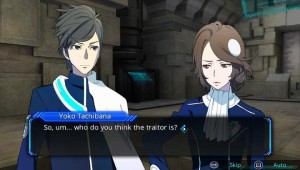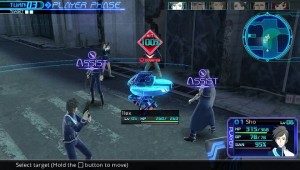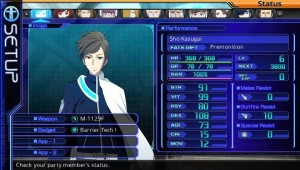Liverpool Sound and Vision Rating 9/10
Lost Dimension is a third-person turn based tactical action role-playing game available for download from the PlayStation Store for the PS Vita with compatibility for PlayStation TV, while also releasing on PS3. Lost Dimension is developed by Lancarse who has previously worked on well received games in the Etrian Odyssey series and Shin Megami Tensei: Strange Journey, while the story is written by Jun Kumagai who has also written scripts for the Persona 3 films and some episodes of the Persona 4: The Animation series as well as other popular names that collectively form an amazing pedigree of quality for the game.
The story revolves around the fate of the entire world resting in the hands of a team of gifted people called SEALED, led by an 18 year old called Sho Kasugai, as a mysterious mad man who calls himself The End has declared total destruction of the world 13 days from his transmission as he ominously maintains that his initial strike was only the prelude of what is yet to come. Sho Kasugai and his team has to ascend a huge tower known as the Pillar in order to have any chance of killing The End but they are pushed to their limits with the deadline of just 13 days hanging over them.
There is a traitor within the team which must be chosen to be removed from the team after each floor of the Pillar has been completed, although what makes it even more interesting is the traitor is randomly generated resulting in how the traitor comes to be and who exactly the traitor is never being precisely the same, while it is even just as possible to mistakenly remove an ally from the team instead of the traitor. The traitor has to be determined by utilising Sho Kasugai’s special ability called Vision which allows him to momentarily see the future, therefore providing clues as to who the traitor may be before making a judgement on the team member he believes to be the turncoat.
Combat is turn based, while allowing freedom of movement within a designated circle in the immediate surrounding environment in front of the most advanced enemy with the combat featuring many intricate components which make for an intriguing combat system which is incredibly rewarding when the effort is invested to learning such important gameplay mechanics.
When the resilience also referred to as sanity of an enemy is reduced to 0; it will leave the enemy in a daze which will greatly reduce their statistics for a single turn, therefore providing an ideal opportunity for the player too deal a large amount of damage to the enemy, although the dazed state will wear off after a single turn for both sides as allies are as vulnerable to such an occurrence as enemies.
If a turn has not exactly gone according to plan, then that is a scenario when defer especially comes into play with a team member spending sanity to use defer to provide the chance to act again, although it can also be utilised to gain an advantage during combat by not just using it after an ineffective turn, but even following up on a turn that swings the battle in the player team’s favour.
An assist attack can become a reality simply by launching an attack on an enemy from the opposing team when the currently selected character is close to another team member with assist displayed above them, although assist attacks only occur if team members trust each other and a certain wariness of enemies is required as they may also use assist attacks when possible. Other such intricate components of combat include counterattacking an enemy which is within a certain range of a normal attack, although enemies can counterattack any of the player’s team if they are within range of whoever is attacking them, while a back attack is when an attack happens from the rear, therefore catching the enemy off guard and increasing the damage dealt in the process.
Team members become berserk when their sanity has been drained to 0 through excessive usage of their gifts resulting in that specific character not being able to be controlled as they will act irregularly leading to an ally being potentially attacked more than an enemy.
Each member of the team has their own special abilities, also referred to as gifts, which require gift points and sanity in order to be performed with a range of amazing abilities such as Himeno Akatsuki who has pyrokinetic powers that allow her to aim a fireball at enemies, Marco Barbato has telekinesis powers which provide him with such power to be able to pick up and crush enemies, Toya Orbert possesses magnetic powers, Sojiro Sagara can heal his team-mates by restoring their health and many more unique powers which compliment the weaponry some of the team members also possess as each team member can only equip specific weapon types.
Before entering into a quest or sub quest, there is a lobby in which the team prepares for battle with such activities as Sho building friendships with his team members by talking to them and getting to know more about them, while players can also set up their equipment. The inventory stores items, of which there are plenty to utilise, such as a range of weaponry to attack enemies in battle, gadgets to improve defences and boost the special abilities of gifts, apps which attach to gadgets to provide further improvements and items such as a health capsule which helps to heal a member of your team, while items can be created for team members by using energy earned in battles or alternatively gaining energy from converting an item back into energy.
XP can be earned by performing appropriately with aggressive attacks, assisting nearby team members in their attacks and defeating enemies as earning XP to level up is important as it allows each team member to remember more of what they had forgotten from amnesia which unlocks more of their special abilities and skills as well as generally improving their statistics.
The ratings system for every quest and sub quest is based upon the quality of the teams’ performance with the major decisive factor of achieving an S rating from the various ratings available being how efficiently the quest or sub quest can be completed in as few turns as possible.
The character design is a joint collaboration between Yuu Yamashita who has worked on the Sword Art Online anime and Makoto Tsuchibayashi who is an extremely popular character designer having created Dante in the Devil May Cry series and having worked on such games as Mega Man Legends, therefore such a collaboration has created excellent character design which has the appropriate amount of variation for ally and enemy characters.
The environment design is not as varied or as inspired as the character design as the surrounding environments look too similar as they mostly include city streets with a variety of buildings such as skyscrapers in ruins and overturned cars in streets amongst the rubble.
There are multiple downloadable content packs available comprising of a free costume and a couple of free optional boosts, additional quests each consisting of five missions on varying difficulty levels for £0.79* each, an additional map consisting of 5 missions for £3.29* and 9 costumes for £0.79* each or a costume set for £4.99*, while there are also some optional boosts for improving statistics and levelling up which mostly cost between £0.39* to £0.79* each other than simultaneously levelling up every team member by three levels which costs £2.49*, although it is important to note that such optional boosts can be completely earned in-game without any additional purchases and do not require long grinds in order to earn them.
The controls are appropriately mapped to the Vita with the control scheme consisting of pressing X to perform an action, pressing triangle to display the map and battle status, pressing square to automatically advance dialogue; pressing O to cancel a selection before launching an attack on an enemy, pressing R or L respectively to toggle to the next or previous page or character, pressing up, down, left or right on the d-pad to select a command or move the cursor, changing the direction of the left analogue stick to move the character or cursor, changing the direction of the right analogue stick to move the camera during battle and pressing start to display the pause menu. There is no touch screen or rear touch pad implementation which could have been utilised to provide a touch based user interface for swiping across the touch screen or rear touch pad to move the character or cursor and tapping the touch screen or rear touch pad on an icon to select an action, special ability or item, while gyroscopic motion sensing functionality could have perhaps been used as an alternative method for utilising special abilities.
Graphically, Lost Dimension possesses an exceptional visual novel style during not only cutscenes, but also dialogue and gameplay which really showcase the characters, their gifts and their surrounding environments appropriately, while the character models during gameplay particularly looking amazing with a consistent frame-rate during movement and combat which certainly helps the flow of the gameplay.
The presentation of the game is solid with a great user interface across various menus such as the main, lobby, talk, setup, options and gameplay menus with support for navigation via the left analogue stick, d-pad and face buttons, although there is no support for navigation via the right analogue stick, touch screen and rear touch pad. The background of the title menu consists of the Pillar standing tall amongst the cityscape in the background and clouds in the sky, while the backgrounds for any further menus revolve around the lobby which has all of the team members standing around preparing themselves for battle.
There is exceptional voice-over talent in the English language localisation such as Mathew Mercer and D.C. Douglas, while the original Japanese language release includes the talents of Yusuke Yamamoto, Takahiro Sakurai, Rumi Okubo and many more talented voice-over artists making their respective characters rather interesting and unique. Sound effects include running, using weapons such as guns, swords and special abilities, inflicting blows to enemies and explosions when mechanical enemies have been drained of their health. There is a frenetic fusion of instrumental dance and arcade music during combat, while there are tense climactic elements to some of the music during cutscenes and dialogue and even a mixture of relaxing and thought provoking music during the lobby area in which the team prepares for battle.
The trophy list includes 36 trophies with 16 bronze, 15 silver, 4 gold and 1 platinum trophy. Easier trophies include The Battle Begins bronze trophy for clearing a quest for the first time; the It’s In Your Hands Now bronze trophy for using defer 20 times and Traitor Candidate bronze trophy for labelling a team member as a suspected traitor with a red marker on the vision screen which can be earned naturally. Harder trophies include The Sealed Truth silver trophy for collecting all 42 tips files which are hidden throughout the game, the Mission Complete gold trophy for clearing all quests and sub quests, although there are quests and sub quests which will only become available on the second playthrough which extends multiple trophies into a second full playthrough of the game and the Perfect Commander gold trophy for completing all quests and sub quests with an S rating. It is estimated that depending upon skill and a good trophy guide to provide some helpful tips that it would take between 21 to 25 hours to platinum the trophy list.
There are two difficulty levels including easy and normal with the major differences being the reduction of damage inflicted by team members on their enemies and an increase to the amount of damage received by team members from enemy attacks as well as an increase in the efficiency of enemy positioning and movement. The difficulty of each quest and sub quest naturally increases from a minimum of a one star rating through to a maximum of an eight star rating with each quest and sub quest progressing in difficulty in comparison to the previous quest and sub quest.
There are no local multiplayer or online multiplayer components and there are no online leaderboards, although there could have been local multiplayer by passing the Vita with one player playing as the SEALED team and another player playing as the enemies which would have fitted the turn based gameplay rather easily, while online multiplayer could have taken the same approach, although there could be the choice of co-operative multiplayer with multiple players on the SEALED team, alongside online leaderboards which could have ranked players accordingly based upon how quickly each player has completed every battle and the lowest amount of combat moves used in each battle.
The replayability stems from many standout features including the randomly generated traitor resulting in the story and gameplay never being entirely the same, a variety of main quest and sub quest missions, an entire set of new quests and sub quests called Memories are unlocked for the second playthrough, 42 tips files which are hidden throughout the environments across multiple playthroughs displaying as luminous objects uncovering secrets of the Pillar and a New Game + feature allowing for statistics and special abilities to carry over from one playthrough to the next which collectively provides dozens of hours of replay value.
Overall, if you are a fan of the role-playing game genre, then Lost Dimension is a worthy addition to your Vita gaming collection as it packs a huge amount of content and genuine replay value with excellent gameplay mechanics and character design, while still managing to be quite accessible even on the go due to its appropriate pacing, therefore making it an essential purchase.
Jason Bonnar
Analysis
- Title: Lost Dimension
- Developer: Lancarse
- Publisher: NIS America (Europe)/Atlus (America)/Furyu (Japan)
- System: PS Vita
- Format: PS Vita Card/PSN Download
- Cross-Buy: No
- Cross-Play: No
- Players: 1
- Memory Card Space Required: 1MB (PS Vita Card)/1GB (PSN Download)
- *Correct at time of publication


